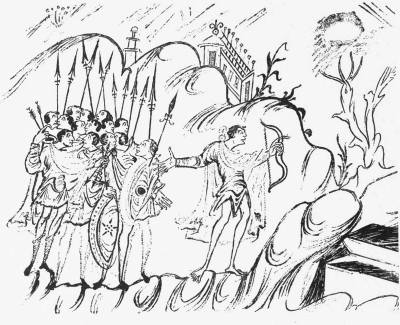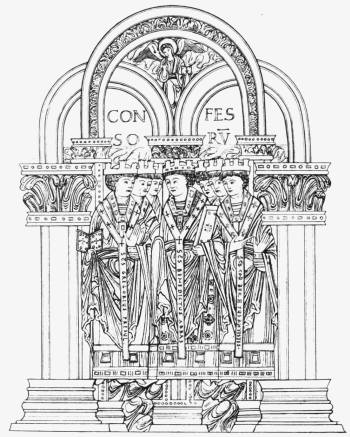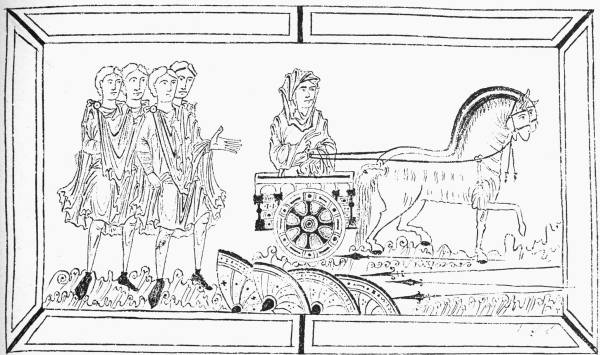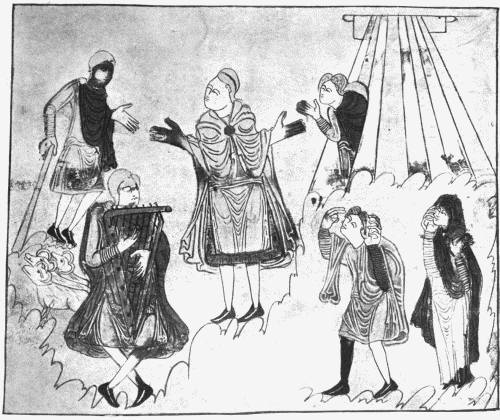

Search london history from Roman times to modern day
151
153
The life of London began again somewhere about the end of the sixth century. As London was created for purposes of trade, and as it fell with the destruction of trade, so it was restored for purposes of trade. The merchants from beyond the seas heard that peace, some kind of peace, had returned to this land; the mouth of the Thames no longer swarmed with pirates, for there was nothing left on which they could prey. From Dover the adventurous merchantman crept timidly along the coast—there was no enemy in sight; the skipper ventured into the narrow channel between Thanet and the mainland—no ship was there, no sign of pirate craft; timidly he sailed up the broad estuary of the Thames—not a sail did he encounter. There were no ships; when the Saxon migration exhausted itself, the Saxon forgot straightway the art of shipbuilding and the mystery of navigation; his ships were to him like those wings on certain insects which provide for the one flight—that achieved, the wings drop off. During the hundred years and more, while the invasion was becoming a conquest, the ships had rotted or been burned. Yet the strange merchants knew not what reception they would meet. Along the low and marshy shores of the Thames, as the estuary narrowed, there was not a sign of human habitation—who would dwell in the marsh when he could dwell on the land? There were no fishermen even. There were no signs of life, other than the cry of the birds whirling overhead and the plunging of the porpoise round the bows.
Presently they arrived at London. They knew it as London—not Augusta, which had been its name for a few years only. There was the bridge of which they had heard; but its planks and piles were falling into decay. There was the sea wall, and, behind, the land wall—grey, overgrown with wall-flowers, with that yellow flower that grows to this day only on and beside Roman stations. The wall was strong yet, though half in ruins. And there stood the ancient gates with their rusty hinges and decayed woodwork. There were the ancient ports which we know as Billingsgate and Dowgate, at the mouth of the Walbrook. There were the quays, broken down and decaying and deserted. Where were the people of London? There was no smoking hearth; there was no smoking altar; there was no sound of blacksmith’s forge, or of any craft, or trade, or business.
154
They moved alongside a quay—it was at Billingsgate; a couple of men landed and the rest waited under arms.
These scouts walked about the quay, and boldly penetrated into the town. After half an hour they returned with the news that the place was really deserted. There was no one there, neither merchant, nor Saxon, nor Briton.

Then these traders landed their cargo and began cautiously to explore the country round, carrying their goods for sale. They found farmsteads dotted about, each containing one family, with its chief, its sons and daughters, and its slaves. They went north and east as far as Ongar and Abridge, and even beyond the great forest. The people received them without any attempt to kill or murder them: they were interested at least in the weapons offered for barter.
What more? Trade revived: the foreign merchants came back, the men of Rouen, the men of Bordeaux; and some of the East Saxons themselves, forgetting their prejudice against towns, came in to settle and took to trade. Some of the Britons came out of their retreats in the forests and found shelter and freedom, and perhaps wealth, in the city. London was founded a second time.
The desertion of London, the solitude of London, the return of the merchants, the repeopling of the place, are not described by historians, but have been related here as they must have happened. There seems to me to be no other way of explaining the facts of the case.
In the beginning of the seventh century London is again mentioned. The following is the testimony of Bede, who wrote one hundred and twenty years after155 the events recorded. The main facts were most certainly remembered, while the actual condition of London at the date would be probably less clearly known. His words are these:—
“In the year of our Lord, 604, Augustine, Archbishop of Britain, ordained two bishops, viz. Mellitus and Justus: Mellitus to preach to the province of the East Saxons, who are divided from Kent by the river Thames, and border on the Eastern Sea. Their metropolis is the city of London, which is situated on the bank of the aforesaid river, and is the mart of many nations resorting to it by sea and land. At that time, Sebert, nephew to Ethelbert by his sister Ricula, reigned over the nation, though he was under subjection to Ethelbert, who, as has been said above, had command over all the nations of the English as far as the river Humber. But when this province also received the word of truth, by the preaching of Mellitus, King Ethelbert built the church of St. Paul, in the city of London, where he and his successors should have their episcopal see. As for Justus, Augustine ordained him bishop in Kent, at the city which the English named Rhofescestir, from one that was formerly the chief man of it, called Rhof. It was almost twenty-four miles distant from the city of Canterbury to the westward, and contains a church dedicated to St. Andrew the apostle. King Ethelbert, who built it, bestowed many gifts on the bishops of both those churches, as well as on that of Canterbury, adding lands and possessions for the use of those who were with the bishops.”
And in the Anglo-Saxon Chronicle we have the following brief entry:—“A.D. 604. This year the East Saxons received the faith and baptism under King Sebert and Bishop Mellitus.”
At this time, then, the King of Kent was the overlord of the Essex men, who had as well their own King. And their “metropolis” was London, where King Ethelbert built their first church—St. Paul’s. Also London was “the mart of many nations.” This was doubtless true in the eighth century when Bede wrote. How far was it true at the beginning of the seventh? Some advance had been made, that is certain. For the Bishop, London was the metropolis, the mother city. Whatever official and central life belonged to the diocese was placed, therefore, in London.
It would be interesting, if it were possible, to trace the gradual change in the manners and customs of the Saxons which enabled them to live in towns. That it was very gradual we may learn from the small number of towns in Saxon England, from the large number of Roman-British cities left “waste,” and from the fact that not until Alfred’s time did they begin to build or to restore the walls of their towns. It was, however, a Saxon population that occupied London as soon as the days of desolation were fulfilled. This is certain from the names of the streets, which, with one doubtful exception, are all Saxon—why the name of the river itself never became Saxon is a fact impossible to explain. First came the merchants with the sailors and156 the ships. They established themselves, as of old, along the river, beside the ports afterwards called Billingsgate and Dowgate or Walbrook. These ports with their quays were easily repaired by means of piles and planks. The ships and traders came with the spring, and in the summer the chapmen, with their caravans of pack-mules and pack-horses, rode from one clearing to another with their wares. Then it became convenient that some should stay all the year at the port. The streets within the river wall began to be reconstructed and houses rose, and the country folk, losing their dread of magic, began to drop in and to settle among the ruins of Augusta and near their new friends the foreign merchants.

The site of the Citadel was still marked by a broad and open area; its walls were gone—we have seen that they were used to build the City wall; it was partly occupied by buildings then in ruins; its four gates were all open—through them ran the road for wheeled vehicles to London Stone, and so down to London Bridge. North of these streets, i.e. north of Cannon Street, lay a great expanse of land, enclosed by the wall, with the remains of Roman villas and the débris of streets and157 houses lying scattered over it. This large area was the ancient Augusta. A great part of it was cultivable land overgrown by trees and bushes, wanting nothing more than the removal of foundations here and there and the clearance of the underwood. Where there is cultivable land there will be land-owners. Before long every acre within the wall had its proprietor. From private property thus acquired by settlement grew up most of the City wards; they were manors belonging to certain families. On this subject I have spoken elsewhere. (See Mediæval London, vol. ii. chapter v.) The Saxon settlement of London, according to this view, followed the return of the foreign merchants. They repaired the quays and restored the ports; it is probable that they repaired the wooden bridge. They occupied that part of Thames Street which lies round the mouth of the Walbrook and Billingsgate. The country people, perceiving that no harm followed, despite the magic of the walls, began to settle in the waste parts of the north within the old walls. There they carved out estates and made farms and orchards, and gradually filled up the whole area, and, also gradually, learned the meaning of trade. As they filled up the area enclosed by the walls, they absorbed the mixed population of foreign residents, craftsmen, and the “service” of the port. This view of a gradual settlement, in the north first, afterwards158 spreading south, seems partly borne out by the broad waste places—the Room-lands and ground in the Saxon city. Thus West Cheap, now a narrow street, was then a broad waste-land; there was another Room-land at East Cheap on the site of the old Roman citadel; and there were Room-lands near Billingsgate and Dowgate. That there was also a Room-land at Newgate may be accounted for by the simple fact that here were the shambles, and that no one cared to settle down, build a house, and cultivate a piece of ground in a place so foul and noisome.

And if Bede is right in saying that London in 604 was a “mart of all the nations,” then this Saxon occupation must have commenced fifty years before—we can hardly suppose a period of less than fifty years for the re-establishment of London trade; but the silence of the Anglo-Saxon Chronicle as to the restoration of London, and the vagueness of Bede’s statement made two hundred years afterwards, forbid us to consider the assertion that London was “the mart of all the nations” to be accepted literally.
As for the people by whom the settlement of London was effected, they could be no other than the East Saxons, the people of Essex. If we look at the map, it is clear that the situation of the town invited them, and that in a very remarkable manner it lay open to them. The river, peculiarly their own river, for they were settled along the coast where it rose above the marshes, conveyed them easily to the place. An impenetrable forest covered the whole of the north, but left a way over a high moorland, between the forest and the marsh, from the settlements along the shore to the walls of London. There was no such way open for the men of Mercia, of Anglia, of Kent, or of Wessex; to them there was only the river.
To the argument from the nature of the site we must add the very important fact that, when first we hear of London restored, the City is under the rule of the King of Essex. It is true that the overlord of Essex was the King of Kent. But if London had been settled by the men of Kent, how would the King of Essex, never so strong as other kinglets, have acquired his right of superiority?
I must, however, refer to a paper read by Mr. T. W. Shore before the London and Middlesex Archæological Society in March 1900, in which he contends that London was resettled from Kent. His argument is, briefly, as follows:—
1. The natural way of outlet or extension for Kent would be up the Thames. That Kentish men did emigrate and settle beyond their marsh is proved by the laws of King Wihtred (A.D. 685), in which it is laid down that Kentish men carry their laws and customs “beyond the march.”
2. Names connected with Kent are common round London E. of Kennington, Kensington, Kenton, Kentish Town, Kenley, Kent’s Town.
3. The Kentish custom of gavelkind, by which the estate was divided among all the sons equally, the youngest son taking the homestead, prevailed, and in some places lingered long in many villages and manors round London, viz. Kentish159 Town, Stepney, Mile End, Hackney, Canonbury, Newington Barrow (Highbury), Hornsey, Islington, Streatham, Croydon, Peckham Rye, Kensington, Walworth, Vauxhall, Wandsworth, Battersea, Lambeth, Barnes, Sheen (Richmond), Petersham, Edmonton, Fulham, Tottenham, Ealing, Acton, and Isleworth.

This list (the authority for which is Thomas Robinson on Gavelkind) is long and unimportant. It becomes more important when Glanville is quoted as saying that partible inheritance was only recognised by the law courts when it could be proved to have been always in use. Now if in the twelfth century the use of gavelkind could be proved customary beyond the memory of man, the antiquity of the use on the manors is certainly established.
London, then, was surrounded by manors under gavelkind. Further out, the Archbishop of Canterbury had demesnes at Harrow and Hayes. In the reign of King John he converted gavelkind fees into knights’ fees.
160
4. Mr. Shore also calls attention to the two claims in William’s Charter, that all burgesses are law-worthy, and that thus every child is to be his (not his or her) father’s heir.
These words prove, he suggests, that there were no bondmen in London, as there were none in Kent, and that gavelkind, the peculiar Kentish custom, obtained in London at that time.
This view is submitted for the readers consideration. Against it we have to set the undoubted fact, as stated above, that the King of Essex was the Lord of London, although his overlord was the King of Kent. Had London been settled by Kentish men, how would the King of Essex get a footing there? Is it not much more reasonable to suppose that the City was first settled by the men of Essex; that the King of Kent became by battle and victory the overlord; that Kentish men naturally flocked to the place and acquired lands, and that they brought with them their own customs? We may thus explain the facts of the names and the Kentish customs. As regards the clauses in the Charter, I fail to see their importance. If there were slaves in London, they would not be accounted burgesses, and would not be named, for slaves had no rights; and the framers of the Charter would naturally use the word “his” rather than “his or her.”
As to the custom of gavelkind, it is thus laid down in the Thirteenth-Century Custumal (see Elton, Origins of English History):—
“‘If any tenant in gavelkind die, having inherited gavelkind lands and tenements, let all his sons divide that heritage equally. And if there be no male heir, let the partition be made among the females in the same way as among brothers. And let the messuage (or homestead) also be divided among them, but the hearth-place shall belong to the youngest son or daughter (the others receiving an equivalent in money), and as far as 40 feet round the hearth-place, if the size of the heritage will allow it. And then let the eldest have the first choice of the portions, and the others afterwards in their order.’”
“‘In like manner as to other houses which shall be found in such a homestead, let them be equally divided among the heirs, foot by foot, if need be, except the cover of the hearth, which remains to the youngest, as was said before; nevertheless, let the youngest make reasonable amends to his co-parceners for their share by the award of good men’” (pp. 189-190).
Trying to avoid privacy and cookie settings overwriting content